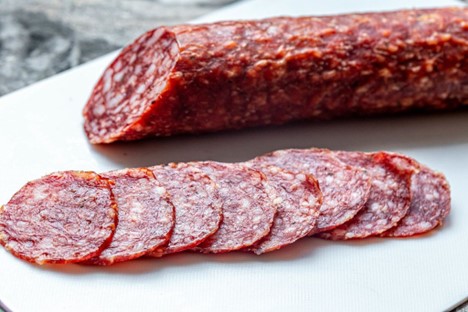Pepperoni, the king of pizza toppings, is a staple in pizzerias worldwide. With its distinct flavor and aroma, it’s hard to resist the allure of this spicy, savory meat. But what do we really know about pepperoni? In this article, we’ll take a deep dive into the history, types, preparation, and current popularity of this beloved pizza topping.
The History of Pepperoni
Pepperoni is a beloved pizza topping that is a staple in pizzerias and homes all over the world. Its history dates back over a century and has been a favorite of many for just as long. The origins of pepperoni are somewhat unclear, but it is believed that it was invented by Italian immigrants in the United States in the late 19th century.
Many believe that pepperoni originated in the Italian-American community in the Northeastern United States, particularly in the cities of New York and Philadelphia. The first written reference to pepperoni dates back to 1919, when a butcher named Giuseppe “Joe” Battaglia opened his own shop in Buffalo, New York. Battaglia started selling pepperoni, which quickly became a hit in the area.
Another theory suggests that pepperoni was created by Italian immigrants in the Midwest, specifically in the city of Chicago. According to this theory, pepperoni was created as a spicy, more flavorful version of salami, a popular cured meat in Italy.

Regardless of its origins, pepperoni quickly became a popular topping for pizza in the United States. It is now the most popular pizza topping in the country, and it is estimated that over 250 million pounds of pepperoni are consumed each year.
Throughout the 20th century, pizza gained popularity in the United States, and with it, so did pepperoni. In 1957, Pizza Hut opened its first location in Wichita, Kansas, and introduced its famous pepperoni pizza, which quickly became a favorite among Americans. In the 1980s, Domino’s Pizza also became a major player in the pizza industry, and its pepperoni pizza was a top seller.
As pizza became more popular around the world, so did pepperoni. Today, it is a common topping in pizzerias across the globe. In fact, some countries have even put their own spin on the classic topping. In Japan, for example, pizza with pepperoni is often served with a drizzle of honey or a sprinkling of corn. In Brazil, pepperoni pizza is often served with green peppers, onions, and mushrooms.

Pepperoni is a versatile meat that is enjoyed on its own or as a topping for pizza. It is made from beef and pork, and is typically seasoned with a blend of spices, including paprika, garlic, and black pepper. It is then cured and smoked, giving it a distinct flavor and aroma.
There are several different types of pepperoni available on the market. Some are spicier than others, while some are milder and more savory. Some are made with beef only, while others are made with a combination of beef and pork. In recent years, turkey pepperoni has also become popular as a lower-fat alternative.
Types and Flavors of Pepperoni
Pepperoni comes in a variety of types and flavors, depending on the region and producer. Some of the most popular types of pepperoni include:
- Regular Pepperoni: This is the classic pepperoni that most people are familiar with. It’s made with a blend of pork and beef and seasoned with paprika, cayenne pepper, and other spices.
- Spicy Pepperoni: For those who like a little extra heat, spicy pepperoni is a great choice. It’s made with the same blend of pork and beef as regular pepperoni, but with the addition of extra spices like red pepper flakes or jalapeno.
- Turkey Pepperoni: For those who prefer a healthier option, turkey pepperoni is a great alternative. It’s made with turkey instead of pork and beef, and has less fat and fewer calories than regular pepperoni.
Despite the variety of flavors and types available, traditional pepperoni is still the most popular. It has a smoky, spicy flavor that pairs perfectly with the gooey, melted cheese and chewy crust of a pizza.
Pepperoni is prepared in several ways, depending on the manufacturer. Some pepperoni is sliced thin, while others are sliced thick. Some are pre-cooked, while others are not. Regardless of how it is prepared, pepperoni is a tasty and convenient topping for pizza that can be easily enjoyed at home or in a pizzeria.
Today, pepperoni remains one of the most popular pizza toppings in the world. It is loved for its bold flavor, spicy kick, and versatile nature. Whether you enjoy it on its own or as a topping for pizza, pepperoni is a classic and beloved ingredient that has stood the test of time.
Current Popularity
Pepperoni is one of the most popular pizza toppings in the United States and has become a staple ingredient in the American diet. The widespread popularity of pepperoni has contributed to the growth of the pizza industry and has had a significant impact on the economy. In fact, pepperoni is the most popular pizza topping in America, with approximately 36% of all pizza orders featuring this spicy and savory meat.
According to a report by Pizza Marketplace, the demand for pepperoni in the United States has continued to increase, with sales reaching a record high in 2020. In fact, 251.7 million pounds of pepperoni were sold in 2020 alone, a 7.9% increase from the previous year. This growth in demand has led to an increase in the price of pepperoni, with some reports indicating that the price has risen by as much as 50% in recent years.
One of the reasons for the popularity of pepperoni is its versatility. It pairs well with a variety of other toppings, such as mushrooms, onions, and peppers, making it a go-to choice for many pizza lovers. Its spicy and salty flavor also adds a unique taste to pizza that cannot be replicated by any other topping.
While pepperoni is most commonly associated with pizza, it has also found its way into other popular dishes. Pepperoni is often used as a topping for sandwiches, salads, and even as a snack on its own. It is also used as an ingredient in various pasta dishes, adding a spicy and savory flavor to these classic recipes.
The popularity of pepperoni has also had a significant impact on the economy. The pizza industry is a multi-billion dollar industry, and pepperoni is one of the key drivers of this growth. The increased demand for pepperoni has led to the creation of new jobs in the food industry, from meat production to pizza delivery. In fact, the pizza delivery industry alone employs over 3 million people in the United States.
In addition to its economic impact, pepperoni has also played a significant role in American culture. It has become a symbol of the American love for pizza and is often used in pop culture references, such as in movies and TV shows. Its popularity has also led to a number of annual celebrations, such as National Pepperoni Pizza Day, which is celebrated on September 20th.
Overall, pepperoni has become a beloved ingredient in American cuisine and has had a significant impact on the food industry and the economy. Its popularity shows no signs of slowing down, and as the demand for pizza continues to grow, so too will the demand for this spicy and flavorful meat.
Conclusion
Pepperoni may have started as an experiment by Italian immigrants, but it has become an integral part of American cuisine and culture. Its piquant, savory flavor has captured the hearts of pizza lovers worldwide. Its versatility in a variety of dishes has made it a household name. Whether you prefer regular pepperoni, spicy pepperoni, or turkey pepperoni, there’s no denying the allure of this beloved pizza topping.
References:
Anon. (2018). The History of Pepperoni. The Great Courses Daily. https://www.thegreatcoursesdaily.com/the-history-of-pepperoni/
Foschino-Barbaro, M. P., & Poutanen, K. (2019). Breadmaking and bakery products. In Handbook of Food Science and Technology 3 (pp. 87-106). Springer.
Guardino, A. (2019). The Margherita: The Story of a Pizza. The Harvard Common Press.
Harris, L. (2017). Pizza and Neoliberalism: A Slice of Hyperreality. Cultural Politics, 13(3), 348–366. https://doi.org/10.1215/17432197-4219211
Helstosky, C. (2008). Pizza: A Global History. Reaktion Books.
Marks, G. (2010). Encyclopedia of Jewish Food. John Wiley & Sons.
McLaughlin, K. (2018). The Fascinating History of Pepperoni, the Most Iconic American Pizza Topping. Insider. https://www.insider.com/history-of-pepperoni-2018-3
National Pork Board. (2016). The Economic Impact of Pork Production. https://www.pork.org/wp-content/uploads/2016/09/Economic-Impact-of-Pork-Production-2016.pdf
Pizza Consumption Statistics. (2022). Statistic Brain. https://www.statisticbrain.com/pizza-consumption-statistics/
Pizza Toppings. (2022). Pizza.com. https://www.pizza.com/pizza-toppings/
Savoring Pizza Around the World. (2019). National Geographic. https://www.nationalgeographic.com/travel/destinations/europe/italy/savoring-pizza-around-the-world/

